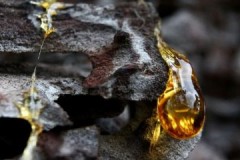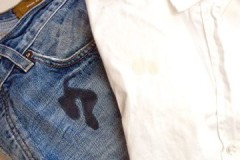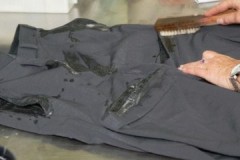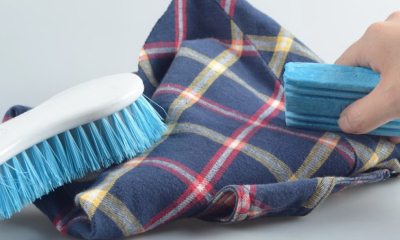 Resin on clothing is a stubborn dirt. To remove it, you need to use special methods.
Resin on clothing is a stubborn dirt. To remove it, you need to use special methods.
For this, both folk methods and professional means are suitable. Cleansing characteristics depend on the type of resin, the structure of the fabric, and the age of the stain.
How and how you can remove resin (wood - birch, poplar, as well as epoxy, composite, etc.) from clothes at home, we will tell in the article.
Content
Preparing for resin cleaning
The difficulty in removing tar from clothing is that the viscous substance very quickly penetrates between tissue fibers... Over time, excess contaminant hardens on the surface, forming a hard crust.
Therefore, before proceeding with the thermal or chemical removal of the tar stain, it is necessary to pre-prepare the clothes and treat the contaminated area.
 Actions are carried out in the following order:
Actions are carried out in the following order:
- Gently clean the item with a brush from dust and dry dirt.
- The lining is stripped off the outerwear.
- Place a board wrapped in cotton cloth under the stain.
- The material around the stain is moistened and sprinkled with talcum powder or starch.
If a resinous build-up has formed on the fabric, primary cleaning is required. To do this, use a knife, scalpel or spatula. The drop is carefully scraped off the surface, being careful not to damage the material.
Take special care when cleaning fine, delicate fabrics... Mechanical cleaning is carried out only with a blunt object.
How can you remove folk remedies?
Stubborn resin can be removed with various household "reagents" that are always at hand. To achieve a positive result, it is worth remembering an important rule: the fresher the stain, the easier it is to deal with it.
Ethyl alcohol, gasoline, turpentine
Purification with these organic solvents is carried out in the following order:
- moisten the stain with the selected liquid;
- stand for several minutes;
- a cotton pad or rag is moistened with a cleaner;
- remove the resin with gentle movements;
- moisten a new cotton pad in a solvent;
- repeat the contamination treatment.
How to clean with nail polish remover?
 For work, you can choose a type of cosmetic product with or without acetone.
For work, you can choose a type of cosmetic product with or without acetone.
The step-by-step cleaning instructions are the same as for alcohol or gasoline.... Differences may lie only in the duration of the procedure.
Liquid for nail polish removes resin or artificial resin weaker, so you need to be patient and have enough cotton pads.
Soap and oil
The adhesives of the resin are water-stable, but readily soluble in oils. This method of cleansing is based on this. So that after the oil there is no greasy residue on the clothes, the product is combined with soap. In this capacity, it is most convenient to use a dishwashing gel.
Cleaning is carried out as follows:
- The stain is moistened with vegetable oil.
- Wait a few minutes for the resin to dissolve.
- The rags are moistened with dishwashing liquid.
- Wipe the problem area until the marks disappear.
How to remove a Coca-Cola stain?
The drink contains orthophosphoric acid. It is on her that the task of dissolving resinous compounds is entrusted. Instead of Coca-Cola any soda with a similar composition can be used:
- Pepsi,
- Sprite,
- Phanto.
The cleansing procedure consists of several steps:
- Coca-Cola is poured into a wide container;
- a spot with a stain is lowered into the liquid;
- withstand several hours;
- the dirt is cleaned off with a soft brush.
Starch
 This home remedy helps restore the appearance of fluffy fabrics. All manipulations are carried out in a specific sequence:
This home remedy helps restore the appearance of fluffy fabrics. All manipulations are carried out in a specific sequence:
- Gruel is prepared from starch and water.
- Apply the paste liberally to the stain.
- Withstand several hours.
- Wash off the starch and dry the area.
- Remove the resin residues with a cloth soaked in gasoline.
Temperature effect
It is possible to remove the sticky spot not only chemically and mechanically, but also thermally. The resin changes its state of aggregation at high and low critical temperatures. This property is used for cleaning.
Freezing
Rapid cooling is suitable if the resin has come into contact with clothing made of durable fabric... The build-up, which has not yet completely absorbed into the fabric, but has not yet dried, is difficult to remove with a spatula. In this case, freezing can help out.
The thing is wrapped in polyethylene so that the resinous spot does not touch the clean cloth. Put the product in the freezer for several hours. After that, brittle dirt is crumbled with hands or scraped off with a spoon.
After freezing, the remnants of crumbs can be easily removed from the surface of the fabric with adhesive tape.
Thawed cubes are replaced with fresh ones until the resin hardens... Then carry out mechanical removal of the contaminant in the described way.
Heating with an iron or hairdryer
This method is most effective for removing fresh tarry stains. An iron or hair dryer is used to heat the fabric.
The procedure algorithm includes several sequential steps:
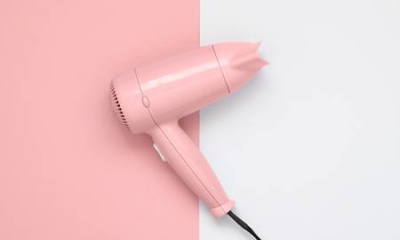 the thing is placed on a hard surface;
the thing is placed on a hard surface;- the stain from below and from above is laid with a cotton cloth;
- heat a section of the product until the resin soaks the cotton gasket;
- change contaminated earbuds for new ones;
- repeat the heat treatment until the stain completely disappears from the product.
Thick cellular paper or paper towels can be used instead of cotton pad.
How to wipe with special compounds at home?
Many housewives do not trust folk recipes and prefer to use special chemistry.... Each product has clear instructions for use and guarantees safe use.
To choose a suitable stain remover, you need to focus on its spectrum of action, cost, consumption, efficiency.
Dr. Beckmann Expert
Liquid stain remover from a German manufacturer is designed to remove:
- resin,
- bitumen,
- machine oil,
- lubricants.
Suitable for stubborn stains on white and colored fabrics. The average price of a bottle (50 ml) is 200 rubles.
The tool is used as follows:
- Wet the stain well with liquid.
- Cover the treated area and leave for a while.
- Thoroughly blot the dissolved resin with a napkin.
Dr. Beckmann Expert cannot be used for cleaning carpets and leather products.
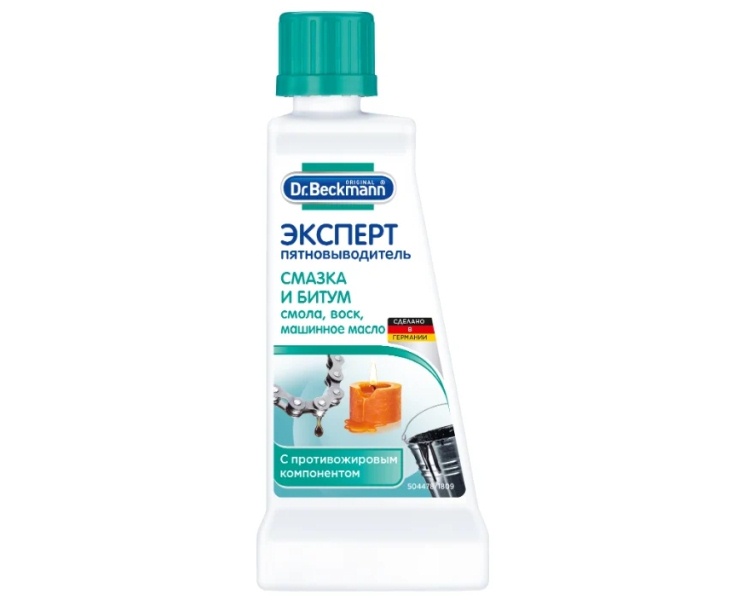
Koch Chemie FleckenWasser
The stain remover is designed to remove:
- oil stains,
- ink,
- resin,
- wax,
- lipstick,
- glue,
- fresh paint.
Can be used on:
- textiles,
- carpets,
- glass,
- plastic,
- metal.
A liter bottle costs about 850 rubles.
The instructions for use include the following processing steps:
- The liquid is applied with a napkin to the problem area.
- With heavy contamination, keep for 3-4 minutes.
- Wipe the stain with a clean cloth with collective movements.
- A stubborn stain is treated with a brush or hard sponge.
After applying Koch Chemie FleckenWasser, wipe the product with a cloth or sponge along the grain.
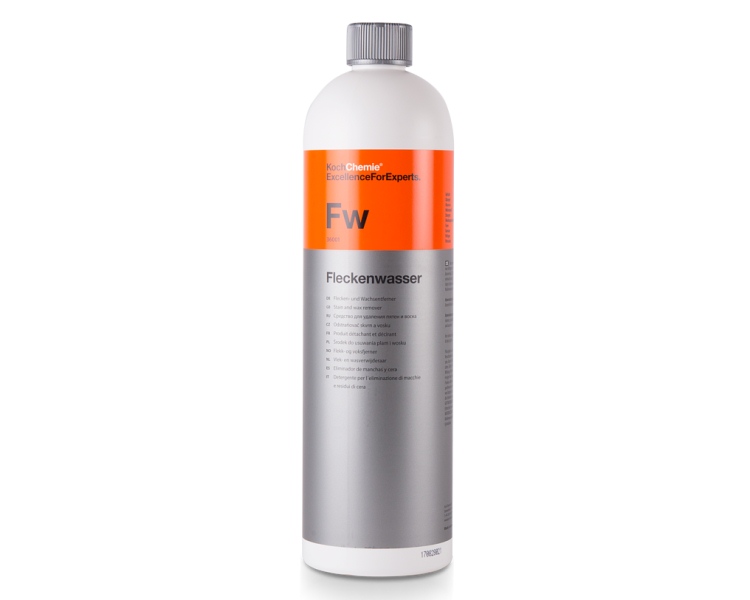
Mellerud
A special cleaning agent from Germany helps to deal with stains:
- glue,
- resin,
- lipstick,
- ink,
- carcasses,
- oils,
- soot.
The stain remover can be used to clean:
- fabrics,
- wood,
- PVC,
- ceramics,
- glass,
- stone.
A 250 ml bottle is sold for 460 rubles.
The algorithm for using Mellerud is as follows:
- The liquid is applied to the resinous spot with a cloth.
- Withstand for a short time.
- Beginning at the edges, remove the resin with a clean cloth.
Mellerud is highly flammable and must be kept away from sources of ignition.
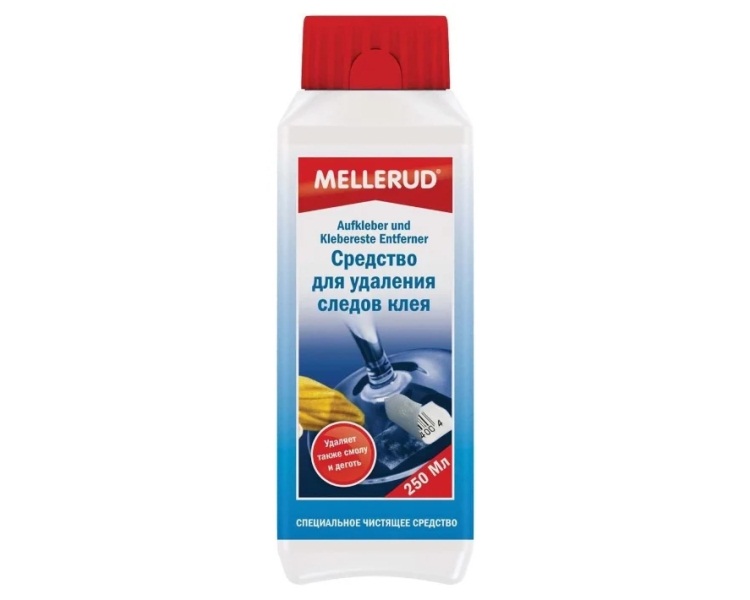
Features of removal from various tissues
In order not to harm the material, you should know what means and methods it can withstand. Often this information can be found on tags or labels of new clothes.
If they have not survived, it is recommended to take into account the following recommendations:
- Cotton. Withstands acetone, alcohol, turpentine, heat treatment.
- Wool, silk... The use of ammonia, turpentine is allowed. Alkalis are not suitable.
- Bologna. Reacts well to gasoline. Does not tolerate vinegar and acetone.
- Nylon, nylon and other synthetics... Do not treat with gasoline, alkalis.
- Leather. Do not use organic solvents. Oil cleaning is ideal.
- Jeans. Withstands ammonia, gasoline, acetone, turpentine.
- Membrane fabric... It is allowed to use turpentine and soap.
The nuances of cleaning various things
The resin removal technique can be influenced not only by the quality of the fabric, but also by the cut of the garment.
- Light wearable items (T-shirts, dresses, shirts, blouses) do not require any special preparation before cleaning. To remove the stain, it is enough to place a plastic or wooden board under the soiled area so that the reagent does not get on the clean part of the product.
-
 Thicker fabrics (shorts, trousers) can be cleaned using organic solvents, heating, cooling.
Thicker fabrics (shorts, trousers) can be cleaned using organic solvents, heating, cooling.In this case, it is necessary to pay attention to the seamy side, which is also impregnated with resin. Brushes and hard sponges are used to clean the resinous particles on these clothes.
- Outerwear (jackets, windbreakers, coats) requires preliminary stripping of the lining. processing is also carried out on the front and seamy side. After washing, which completes the cleaning process, the lining is sewn into place.
- Footwear (sneakers, shoes, boots) are cleaned of resin, taking into account the nature of the material. If it is rubber, natural or artificial leather, use oil, kerosene. Suede and nubuck shoes are cleaned with starch or with the help of professional products.
Will tell you about removing resin stains from jeans this publication, from trousers - this.
Wood and synthetic
Resinous substances come in different origins. There are two types of resin:
- Natural.
- Synthetic.
The first group includes tree resin:
- pine trees,
- fir,
- ate,
- larch,
- poplars,
- birch.
The category of synthetic substances includes:
- epoxy,
- polyester,
- composite and other resins.
They are distinguished by fast hardening, increased resistance to the action of acids and alkalis, therefore their removal is a more complicated and laborious process.
You can find out about how to scrub the resin from pine from clothes here.
What shouldn't be done?
The use of each cleanser requires certain rules to be followed. However, there are general guidelines and prohibitions.
When removing natural and synthetic resin, you must not:
 Wash the item until the stain is completely removed. A hasty wash may cause the resin to spread to an even larger area of the fabric.
Wash the item until the stain is completely removed. A hasty wash may cause the resin to spread to an even larger area of the fabric.- Scrape off the stain with a sharp blade. This can lead to damage to the product, especially if it is sewn from silk, chiffon, wool.
- Freeze things made of thin, quickly tearing fabrics in the freezer, as they can be easily damaged when removing the hardened drop.
- Use acids, alcohol, solvents to clean bright fabrics. Organic reagents can discolor the fibers.
Additional Tips
Removing the resin is a delicate process that depends on many factors. Therefore, when cleaning, you should remember about important recommendations:
- It is necessary to start cleaning immediately after the appearance of resinous contamination. This increases the chances of complete retention of the color and structure of the fabric.
- It is best to have expensive items dry cleaned immediately. Home experiments can spoil the look of an exclusive item.
- The chosen product should be tested on an inconspicuous area of clothing. This will protect it from damage if the reagent turns out to be aggressive towards the material.
- After the stain has been removed in one way or another, the thing is washed manually or automatically.
For recipes and tips for removing tar from various surfaces, see this section.
Conclusion
Resin contamination of clothing is a frustrating but solvable problem. You can remove the stubborn sticky pollution with folk remedies or special chemistry.
It is important to consider:
- resin type,
- fabric structure,
- kind of clothes,
- the age of the stain.
If all the nuances of cleaning are observed, it is almost always possible to return the product to a presentable appearance.
